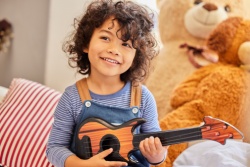
Blog

Importance of Music and Movement in Early Childhood Education
In the joyful environment of preschool classrooms, music is a critical element that brings everyone together. Whether singing along to a familiar tune, dancing in a circle, or clapping hands to a rhythm, music, and movement can instantly light up the faces of young children. Moreover, on a more serious note, these fun moments are incredibly powerful components of early childhood education.
At Valley Heights Preschool, we envision music and movement as much more than just enjoyable extracurricular activities, but as essential tools for growth and development. Their key roles in helping children thrive are discussed below.
Brain Development: Recent studies indicate that when the human brain is exposed to music, its areas related to memory, language, and emotional regulation are simulated. When a child moves to music by swaying, clapping, or marching, they build critical neural connections capable of supporting cognitive development and motor coordination.
With the help of rhythmic patterns, children can improve their memory and recognise sequences. Songs such as “Twinkle Twinkle Little Star” introduce them to repetition, rhyme, and a structure that makes it easier for children to anticipate what comes next.
Language and Communication: It is surprising how quickly and proactively children pick up words from their favourite songs. Singing is one of the best ways to expose them to sentence structure, proper pronunciation, and new vocabulary in a fun way. Action songs that combine language with physical movement can reinforce meaning through experience.
Music also encourages turn-taking and listening, two extremely important components of effective communication. Music helps children learn to wait for their part while signing, carefully listen to instructions, and express themselves through movement and voice.
Physical Development: It is possible to promote the development of both gross and fine motor skills in children with the help of movement activities set to music. By marching to the beat of a drum or tapping a tambourine, they refine balance, coordination, and body awareness.
Music and movement are components of our daily routines at Valley Heights Preschool because we understand how it supports physical confidence. Activities such as hopping, dancing, marching, and stretching build muscle control and create a strong foundation for other important skills such as sports, writing, and self-care.
Emotional Expression: Music is often referred to as the universal language of emotion. Even children who are too young to express their feelings in words can communicate through songs and movement. Music is a safe space for the exploration of different feelings such as excitement, frustration, joy, and sorrow. Whether it’s an upbeat dance tune or a calming lullaby, music helps children connect with others and regulate their emotions.
Social Skills and Cooperation: By encouraging them to participate in musical activities in groups, it is possible to create social learning opportunities for children. In this fun and engaging shared experiences, children learn to cooperate with peers, follow directions, and respect personal space.
Memorable and Joyful Learning: Above everything, music, and movement are excellent tools for making learning enjoyable. While having fun, they are much more likely to be curious, engaged, and open to new experiences. With the help of just a simple tune, it is possible to transform a mundane activity into a game every moment of learning into a cherished memory.
At Valley Heights Preschool, the power of music and movement is embraced every single day. Through dance, rhythm, and song, we help children grow into capable and confident learners.
